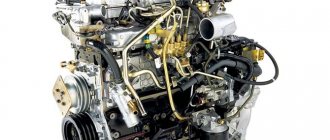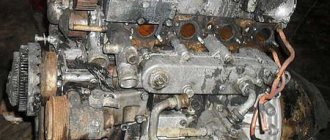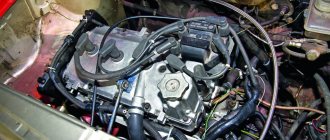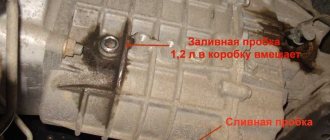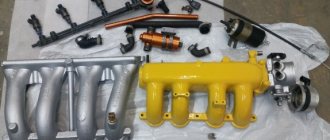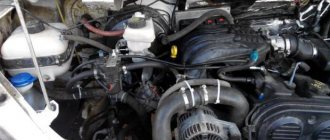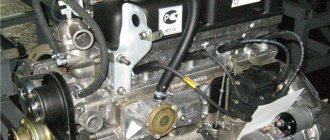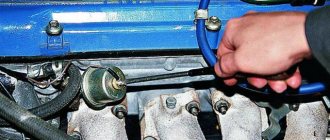The cost of the work is 80,000 rubles.
The cost of registration is 45,000 rubles.
In addition to GAZelles, we install Japanese engines in: Volkswagen Crafter, Mercedes Sprinter, Ford Transit, IVECO and other cars. We will help you legalize the conversion of your car. Possibility of installing gas equipment. When installing LPG, you get significant savings on fuel (up to 50%), there is no loss of power when using LPG of the 4th generation. Also, LPG of the 4th generation does not “dry out” the engine, and given the poor quality of gasoline, you significantly extend the service life motor.
Example of a GAZelle 1JZ-GE swap (No. 1) Example of a GAZelle 2JZ-GE swap (No. 2) Example of a GAZelle swap NEXT 1UZ-FE (No. 3) Example of a GAZelle 2JZ-GE swap (No. 4) Example of a GAZelle 2JZ-GE swap (electronic panel) (No. 5) Example of swap Sobol 1KZ-TE 4WD (No. 6) Example of swap GAZelle 2JZ-GE (No. 7) Example of swap GAZelle 5VZ-FE (No. 8) Example of swap GAZelle 2JZ-GE (No. 9) Example of swap GAZelle 2JZ-GE (No. 10) Example of a GAZelle swap 2JZ-GE (No. 11) Example of a GAZelle swap 2JZ-GE (No. 12)
Author: Dmitry_swap
The GAZelle has become a symbol of new times and new commodity-money relations. It symbolizes small and medium-sized businesses, and there is simply no replacement for it in this price segment. In terms of profitability, GAZelle is in first place from Kamchatka to the Carpathians.
But it also has disadvantages that you cannot always solve with your own hands. First of all, this is the lack of a sensible, efficient diesel engine, but this problem can be solved with the help of a contract engine from Japan.
You can always replace the engine. Here the question is not even about registration, but about profitability. The cost of a new imported engine is another GAZelle, so this option is eliminated. An engine from disassembly is also a rather dangerous option, because no one knows what it went through. Therefore, there is a simple and so far the only reliable way to install a Japanese gasoline engine in a GAZelle. Another name for this is GAZelle swap. This is a contract engine.
This term began to be heard quite recently, but the opportunity to buy a contract motor has always been there. This is a unit that has mileage in the States, Europe or Japan, but is subject to contractual obligations. That is, when buying a contract motor, we receive a guarantee that it will last a certain amount of time without capital. This means that we buy a completely legally clean engine with all possible documents, payment of customs duties and all specified attachments, including the gearbox. This is a legal engine, not one purchased from a suspicious disassembly site, and it comes with a full package of documents for registration with the traffic police.
In addition, we can be sure that: - the engine was filled only with high-quality fuel and operated on excellent oils; — the engine has not been serviced on the lap or in the garage; there are normal workshops for this in Japan; — the engine was serviced strictly according to regulations, since a Japanese would rather commit hara-kiri than miss a scheduled oil change; - as a result, a high service life, maintainability and Japanese build quality, and not a Chinese license.
Experience has shown that several Toyota and Nissan models have become the most recent and most suitable diesel engines; Mitsubishi in this company is represented by only two engines. So, if we talk about Toyota, these are 1jz, 2jz, 5vz, 1uz, Nissan is also represented by a whole line of engines: TD27T, TD27ETI, QD32ETI and QD32T. These engines are installed on Terrano, Pathfinder, Patrol SUVs and on Urvan and Caravan minibuses. Initially, these engines were developed for boats and military water transport, so you can imagine the potential they have.
The TD series engines have a cast iron cylinder head. This suggests that the motor is very resistant to overheating and cold, it warms up perfectly, and cracks between the valve seats are excluded in its head.
On Nissan diesels, the camshaft is gear driven. It is a little noisier than a belt one, but in terms of reliability it has no equal. Now you don’t have to change the camshaft drive belts or restore the gas distribution mechanism in the event of a belt break. The motors are structurally simple and well maintained, without acrobatics and additional complex pullers. These engines are economical. So, on a tented GAZelle the consumption is about 10 liters per hundred. The ETI series engines are equipped with an electronically driven high-pressure fuel pump, the reliability of which has been proven over the years. The T series has a mechanical injection pump, and this makes it reliable, easy to adjust and operational even in the event of an electronics failure. These are just some points that are not described in the technical specifications, and are most important for domestic consumers.
Conversion of Gazelles is becoming increasingly popular.
Contract engines have opened the way to life for many companies that have established connections with foreign partners and are ready to completely, turnkey, replace the GAZelle engine and gearbox with Japanese units. The service will become more popular the more GAZelles approach the 50 thousand km mark, because the price of an internal organ transplant is comparable to the price of a new Cummins engine. Some compensation for the operation may be the sale of old gearboxes and the original gasoline engine. One way or another, prices in Moscow for installing a three-liter 105-horsepower QD32ETI engine with an Atlas gearbox are about 250 thousand rubles, and the same kit, but with a 2.7-liter TD series engine, is 10-15 thousand cheaper. In addition to the GAZelle, engine installation is also carried out on Sobol and UAZ cars.
In addition, it is possible to install both manual and automatic transmissions. Also in some cases it is necessary to make changes to the rear gearbox.
Gasoline costs
- — 1JZ 10-15 liters
- — 2JZ 12-17 liters
- — 1UZ 15-20 liters (this is a 4 liter V8 that easily drags 4 tons at a speed of 140 km/h)
Data
The owner of a Gazelle buys a new 405 engine every year, since the engine simply “dies”, while the mileage is 120-130 thousand km. The price of the new 405 ranges from 112 to 140 thousand rubles, depending on the region.
Japanese engines are very unpretentious and in fact only need to change the oil and filters. It is also worth noting the improvement in vehicle dynamics, because an increase in engine power entails faster acceleration from zero, as well as improved dynamics when driving even on the longest hills. Comfortable control. An optimally selected gearbox will ensure easier handling of your car. Units from Japanese companies are famous for their reliability, which means they will not cause you unnecessary trouble.
Video review of a Gazelle with a 2JZ-GE engine from Academician.
Operating principle of a manual transmission
The operation of this device is carried out according to the principle of gear ratio. The basis of the design is an intermediate shaft that connects the other two - input to output. To change the gear ratio, the driver switches gears. This is a manual transmission with movable carriages.
Its disadvantage is the noise when disconnecting and engaging with another gear, moreover, this is a rather complicated process. Moreover, if you divide the speed of the first gear by the speed of the second, it will be equal to the number of teeth of the first gear divided by the number of teeth of the second.
There is no such problem in a mechanical gearbox with constant mesh gears. The principle of its operation is that a conditional connector moving along the shaft connects it to the gears. In this case, the teeth are constantly in an interlocked state.
Operating principle of a manual transmission
The output gears are in a non-rigid connection with the shaft; for this purpose, there is a gap between them. If, using a conditional connector, the shaft is rigidly connected to only one gear, it will set the rotation speed. When a conditional connector rigidly connects a shaft to certain gear elements, the speeds change. In fourth gear, the output and input shafts become directly connected.
The process of switching gears on a manual transmission
Each gear has a synchronizer, consisting of a friction cone and a locking ring. The gear is rigidly attached to the shaft, and a freely moving coupling is put on it. As the clutch moves, it engages the synchronizer teeth, and the gear and input shaft rotate in unison. The desired clutch is achieved, but when closed, the gear and shaft rotate at different speeds.
It is the blocking ring that allows you to equalize speeds. It can not only rotate with the gear, but also move along the axis. Before moving the clutch, the driver depresses the clutch pedal, but there is no power flow. When moving, the clutch presses the locking ring against the synchronizer cone. Due to the high friction force between these two parts, the speed of the gear becomes equal to the speed of the shaft.
The clutch then moves further and engages the gear so that it is locked with the shaft. Using the same principle, the transition to other gears is carried out, which is switched using a lever. The fifth position of the box is intended to rotate the output shaft at a speed higher than that of the input. For reverse gear, a device of three gears is used. The gears are not synchronized with the mechanism, so the gearbox must be stopped before reverse is engaged.
The principle of operation of a manual transmission in different gears
An example of one of the replacements (SWAP) for 1JZ-GE
In the end, what's done
: - replacing the native Ulyanovsk engine with a Japanese 1JZ-GE - the original panel was left and synchronized - the original speed sensor is synchronized with the Japanese engine - a temperature sensor is connected - a tachometer is connected - the manifold and exhaust pipe are welded - a new required length of the driveshaft is made - new mountings for the airbag are made and boxes - all electrical is connected
Approximately 130 thousand rubles were spent on the purchase of an engine, spare parts, etc.
First start of the 1jz engine on Sobol.
Removing the original engine.
Delivery of engine for replacement 1jz-ge.
It is necessary to convert the collector into one pipe, and also synchronize the original speed sensor.
The 1jz-ge engine is installed, connected to the system.
The final stage of installing the jz engine.
Electrical work.
The final stage.
The replacement of the Sobol engine with the Japanese 1jz-ge engine has been completed.
Author: Dmitry_swap
And now my objections, based on personal experience:
- I’m not a fan of drifting and speeding up at traffic lights, so the power and quick acceleration of the manual turned out to be only a potential advantage for me, which was not useful to me. But, having driven tens of thousands of kilometers through city traffic jams, I appreciated how convenient it is when you don’t have to constantly grab the lever and press the clutch.
- Oil consumption is higher - I don’t deny this, but these are minor things. You need to change the oil on time and generally take care of the car, then there won’t be any wild oil leaks.
- In winter, I started up without much trouble even at -28°C - it couldn’t be colder, the climate is like that. And I calmly drive along the snow-covered, unclean road in a low gear, watching how the manual skids.
- Repairs are affordable in any case - be it manual or automatic. But if you operate it wisely and treat it with care, the machine will serve faithfully, and much longer than stated by the manufacturer.
Here's another observation. Outside the city, on off-road terrain, the automatic car also shows good cross-country ability. Contrary to the belief of the “mechanics”, the automatic transmission is capable of quickly changing gears, so I skipped even where the mechanics sat tightly.
Of course, I haven’t renounced manual transmission forever—I sometimes drive a company car with a manual transmission. I don’t think that changing gears is backbreaking work; the arms and legs remember and do their job.
But still, here is my firm opinion: any automatic transmission is much more comfortable than a manual one. When you've been driving for more than a hundred thousand kilometers, once you've tried something better, you won't want to go back to the worst.
Apply the gas brake, press it quietly and enjoy the ride, and don’t have to think about how many revolutions there are on the tachometer. You can consider it laziness or degradation - but I don’t care! Machines should be for people, not the other way around.
Another GAZelle swap. Engine 2jz. Internal view - replacement of the selector and panel.
Differences and advantages
It is better to install an engine from the Japanese manufacturer Toyota on the GAZelle, because... such a power unit has a number of advantages:
The Japanese mechanism helps:
Thanks to the automatic transmission, which comes with the power unit, the gear shifting procedure is simplified.
Installation of 1UZ-FE on GAZelle NEXT
Owner reviews and prices
The average price with the installation of a Toyota engine is 165,000 rubles.
Alexander, 41 years old, Armavir: “I recently decided to replace the Cummins engine with a unit from Toyota. Now there are no malfunctions, all elements work properly. Average fuel consumption has decreased and vehicle power has increased. The engine itself is easy to maintain, I recommend it.”
Leonid, 33 years old. Yekaterinburg: “The main advantage of such an engine is the reduction in diesel fuel consumption. From 22 liters per 100 km, this figure dropped to 13 liters. The replacement took about two weeks. I decided to entrust this matter to specialists; the whole procedure cost 180,000 rubles. I changed the engine about six months ago.”
Konstantin, 47 years old, St. Petersburg: “This is a reliable unit with high technical performance. The main advantage of such an engine is its ease of maintenance. I changed the mechanism about a year ago. During all this time there were no breakdowns or malfunctions.”
Andrey, 30 years old, Nizhny Novgorod: “The only drawback is the short life of the spark plugs. They have to be changed every 3-4 months. Otherwise the motor works fine. It has a simple design, so repairs can be done by yourself. All spare parts are freely available on the market.”
Dmitry, 42 years old, Rostov-on-Don: “This is a good and reliable engine with high technical performance. Over the 4 years of operation, I managed to highlight several advantages. For example, the engine is unpretentious in terms of fuel quality and has a long service life.”
Source
Installation of a Japanese diesel engine Toyota 1KZ-TE 4WD on Sable.
From a noble family
As noted, the increasingly popular trend of transplanting imported hearts into domestic cars in the vast majority of cases occurs not with new cars, but with used ones. The base engine of such a car is either pretty worn out and requires expensive repairs, or has completely exhausted its service life. And due to the disappearance of bureaucratic control over the power units used in registered vehicles, owners are trying not only to replace a failed standard engine with a more powerful one, but also to ultimately obtain improved dynamics, comfort and an increased service life. In this regard, time-tested 6-cylinder Toyota engines with an in-line and V-shaped cylinder arrangement, the legendary JZ and VZ series, respectively, deservedly take their place under the hood of GAZelles, Soboleys, Barguzinovs and Volgas.
The practice of using these engines in Japanese and American business and executive class cars Toyota Mark II, Aristo, Crown, Cresta, Chaser, Lexus GS300 and others has more than once demonstrated record reliability and a service life of one million kilometers, unattainable for modern ultra-eco-friendly turbo engines. The safety factor built into these engines and the versatility of use (from business class sedans to full-fledged SUVs) made it possible to place these power units even in light commercial vehicles. Moreover, the original Aisin automatic transmission, which comes complete with Japanese engines, is installed along with the engine.
Installation of 2JZ-GE on GAZelle.
Stung "one and a half"
A short introductory test of the converted lorry made it clear why their owners are so happy. Until the engine starts, the only things that confuse the interior of the converted GAZelle are the unusual automatic transmission selector in place of the “poker” and the absence of a clutch pedal. Therefore, instead of using the clutch when starting, I depress the brake pedal and... Oh, miracle! Instead of the usual sluggish activation of the starter, the smooth bass of a perfectly balanced multi-cylinder engine comes from under the hood. Without spinning up to 2.5–3 thousand rpm, the JZ does not allow itself to be identified by its sound. And the silence in the cabin, which is not typical for the Nizhny Novgorod “one and a half”, and the lack of vibrations first makes you look at the tachometer needle to make sure whether the engine is running.
But we can’t wait to test his work in action. To do this, I move the automatic transmission selector to the Drive position and release the brake pedal, and the car, like a passenger car “on automatic,” begins to move without pressing the accelerator, providing an acceptable speed for careful maneuvering in tight yards. But, having left the territory of the service center, the Japanese power unit demonstrates other sides of its character: the acceleration dynamics even with the accelerator pedal pressed halfway are impressive. This is how modern passenger cars accelerate, unencumbered by a frame, rear axle and a 5-meter tent body. If you want to start sharply or make the fastest possible acceleration, there is a “kick-down” button under the accelerator pedal, which brings the engine to maximum output and keeps the speed in the range of 4.5–7 thousand. In such modes, even with a non-original exhaust system, the sound of the JZ engine cannot be confused with anything.
According to owners who already operate GAZelles with a JZ engine and automatic transmission, the fuel consumption of an empty car in urban conditions is 11–12 liters per “hundred”. With a total weight of 3.5 tons, it increases by about 1/3, but still does not exceed the values of the outdated 4-cylinder UMZ-4216.
But I had the opportunity to drive the most modest 2.5-liter version of the Toyota 1JZ GE and not the lightest GAZelle. It’s even scary to imagine what kind of dynamics the lightweight Sobol with a 260-horsepower V8 1UZ FE demonstrates.
And yet, despite all the advantages of the GAZelle with a Toyota engine, compared to a serial gasoline car, I came to the conclusion that these cars cannot become mass-produced. To drive a commercial vehicle with more than 200 horsepower with dependent rear suspension, without ASR and ESP, you need to have the highest driving qualifications. And with a novice and spirited driver behind the wheel, such a 3.5-ton car will be extremely dangerous for others.
Source
Installation of 5VZ-FE on GAZelle.
GAZelle with automatic transmission and Japanese engine: pros and cons
The cost of registration is 45,000 rubles.
In addition to GAZelles, we install Japanese engines in: Volkswagen Crafter, Mercedes Sprinter, Ford Transit, IVECO and other cars. We will help you legalize the conversion of your car. Possibility of installing gas equipment. When installing gas equipment, you get significant savings on fuel (up to 50%). There is no loss of power due to the use of 4th generation gas equipment. Also, the 4th generation LPG does not “dry” the engine, and given the poor quality of gasoline, you significantly extend the life of the engine.
Example of a GAZelle 1JZ-GE swap (No. 1) Example of a GAZelle 2JZ-GE swap (No. 2) Example of a GAZelle swap NEXT 1UZ-FE (No. 3) Example of a GAZelle 2JZ-GE swap (No. 4) Example of a GAZelle 2JZ-GE swap (electronic panel) (No. 5) Example of swap Sobol 1KZ-TE 4WD (No. 6) Example of swap GAZelle 2JZ-GE (No. 7) Example of swap GAZelle 5VZ-FE (No. 8) Example of swap GAZelle 2JZ-GE (No. 9) Example of swap GAZelle 2JZ-GE (No. 10) Example of a GAZelle swap 2JZ-GE (No. 11) Example of a GAZelle swap 2JZ-GE (No. 12)
Author: Dmitry_swap
The GAZelle has become a symbol of new times and new commodity-money relations. It symbolizes small and medium-sized businesses, and there is simply no replacement for it in this price segment. In terms of profitability, GAZelle is in first place from Kamchatka to the Carpathians.
But it also has disadvantages that you cannot always solve with your own hands. First of all, this is the lack of a sensible, efficient diesel engine, but this problem can be solved with the help of a contract engine from Japan.
You can always replace the engine. Here the question is not even about registration, but about profitability. The cost of a new imported engine is another GAZelle, so this option is eliminated. An engine from disassembly is also a rather dangerous option, because no one knows what it went through. Therefore, there is a simple and so far the only reliable way to install a Japanese gasoline engine in a GAZelle. Another name for this is GAZelle swap. This is a contract engine.
This term began to be heard quite recently, but the opportunity to buy a contract motor has always been there. This is a unit that has mileage in the States, Europe or Japan, but is subject to contractual obligations. That is, when buying a contract motor, we receive a guarantee that it will last a certain amount of time without capital. This means that we buy a completely legally clean engine with all possible documents, payment of customs duties and all specified attachments, including the gearbox. This is a legal engine, not one purchased from a suspicious disassembly site, and it comes with a full package of documents for registration with the traffic police.
In addition, we can be sure that: - the engine was filled only with high-quality fuel and operated on excellent oils; — the engine has not been serviced on the lap or in the garage; there are normal workshops for this in Japan; — the engine was serviced strictly according to regulations, since a Japanese would rather commit hara-kiri than miss a scheduled oil change; - as a result, a high service life, maintainability and Japanese build quality, and not a Chinese license.
Experience has shown that several Toyota models, several Nissan models, and Mitsubishi in this company are represented by only two engines. So, if we talk about Toyota, these are 1jz, 2jz, 5vz, 1uz, Nissan is also represented by a whole line of engines: TD27T, TD27ETI, QD32ETI and QD32T. These engines are installed on Terrano, Pathfinder, Patrol SUVs and on Urvan and Caravan minibuses. Initially, these engines were developed for boats and military water transport, so you can imagine the potential they have.
The TD series engines have a cast iron cylinder head. This suggests that the motor is very resistant to overheating and cold, it warms up perfectly, and cracks between the valve seats are excluded in its head.
On Nissan diesels, the camshaft is gear driven. It is a little noisier than a belt one, but in terms of reliability it has no equal. Now you don’t have to change the camshaft drive belts or restore the gas distribution mechanism in the event of a belt break. The motors are structurally simple and well maintained, without acrobatics and additional complex pullers. These engines are economical. So, on a tented GAZelle the consumption is about 10 liters per hundred. The ETI series engines are equipped with an electronically driven high-pressure fuel pump, the reliability of which has been proven over the years. The T series has a mechanical injection pump, and this makes it reliable, easy to adjust and operational even in the event of an electronics failure. These are just some points that are not written in the technical specifications, and are most important for domestic consumers.
Which internal combustion engine is better to use gas 2217?
Cummins ISF 2.8 and 3.8 Quite popular models. As with the 405 engine, there should be no problems with spare parts. Both the original and analogues.
3 Good answer
There are no complaints about the 405 engine. But if you ride in temperatures that are too sub-zero, you can install Webasto for complete peace of mind. And Cummins, of course.
What is the gas consumption on the UAZ Patriot?
from 10 years of ownership experience: on 33″ wheels:
Highway up to 90-100 km/h 12-14l
Route 100-130 17-20l.
In mud, mountains, swamps up to 50 liters if you drive somehow and indefinitely if you stand up
1 0 · Good answer
Is it worth working on your gazelle?
Look at the market entry parameters. It’s very easy to get a license and buy a cheap GAZelle. This means the competition is high. If competition is high, it is difficult to find a job. Since there are many GAZel drivers, the salaries are low. Draw your own conclusions. If you don’t “stick” to the cargo owner on an ongoing basis, I would not work for GAZelle. And generally a driver. In our country, everything is bad with the roads, with road accidents, with traffic police. The social status of drivers is not very good. Better learn something else. You can become a driver at any time. Strive for more if you are not a romantic of the roads.
3 2 · Good answer
Why is a car with a diesel engine better than a petrol one?
The one who answered above is a sheep. A diesel engine consumes less because it has a slightly higher efficiency, but if we take naturally aspirated diesel engines with the same displacement as a gasoline engine, then the diesel engine will lose a lot, it will only gain a little in fuel economy, but this difference is offset by the more expensive repairs. Diesel, due to the fact that in pots at 30 atmospheres, has a more interesting torque graph. From low revs, 1000-1500rpm, it has a higher torque than the gasoline one, but at 3000rpm it already falls apart, its torque begins to FALL, while the gasoline one has not even risen to its peak yet, at the same rpm. So there is a myth that diesel pulls better and is more powerful, it is not more powerful and does not pull better, it just has almost all the torque at once and from below (low-end engine) and gasoline is higher and therefore consumes more, because you turn it more simply to get the same torque. If you make a racing diesel engine, then its resource will be several times less than gasoline, and the price will be an order of magnitude higher. The same HELLKAT has more torque with 7 liters of gasoline at 1200 rpm than the Nissan GTR at its peak at 6 thousand rpm. At the same time, a 7L Hellcat consumes fuel when driving quietly like a 3L European, because the torque from below is such that it doesn’t need to press the gas pedal at all.
Diesel is practical only for commercial vehicles, for those who drive three times more than the average person. Which is exactly what Europeans are like, unlike the CIS. That’s why diesel engines are king there, but in the USA Gasoline is everything.
8 Good answer
Is it worth installing an HBO on a car?
It is worth installing an LPG on a car if you use it very often. For example, you work in a taxi, you are engaged in passenger transportation. It is very important that the equipment is installed by professionals.
Source
Simple implantation
The entire conversion process takes two weeks, and in the case of the one we are describing, it takes place on its technical base. From the GAZelle provided by the client, the entire power unit is removed, including the engine with wiring and all attachments, a gearbox with a lever in the cabin, as well as a driveshaft, the original control unit (MIKAS), fastening elements, an exhaust and a cooling system. All this is given to the client, although it would be nice if the company took the removed parts for sale or disposal, thereby providing the client with an additional discount. So next to the tuners there is a place for a business selling illiquid goods!
In the vacated engine compartment, new mounting points are installed for the Japanese power unit, an engine with an automatic transmission is installed, and new wiring is laid. A new driveshaft is made individually for each car, since onboard GAZelles are often lengthened outside the factory and they have completely different wheelbase sizes, and when installing a different power unit, the distance from the gearbox output shaft to the rear axle gearbox changes. On some cars, the rear axle gearbox is also changed to a faster one. Certain changes are also made to the front facing panel of the cabin, on which a new engine radiator and automatic transmission heat exchanger are mounted, and a pair of electric fans are mounted in front of them.
Questions about installing Toyota engines in Gazelle, Sobol. | Topic author: Zevach
In this topic you can ask any questions regarding the installation of Toyota Engines in Gazelle, Sobol.
Denis (Ajali) What is the consumption if you put a Japanese car with an automatic transmission on a Barguzin and with original brakes?
Malki It all depends on the engine model, on average from 12 to 15 liters, in the “sneaker to the floor” mode about 20. Moreover, the V8 consumes the least with a quiet driving style. HBO is installed on these engines without problems.
Roman (Dru) Denis, Installing the engine does not affect the brakes, if they suit you now, then you can leave everything as is. A vacuum cleaner with a Bosch GTZ, plus high-quality pads give a good result, in my opinion, for some people even 8-piston calipers are not enough.
Malki Roman is right, the Business vacuum cleaner greatly improves the situation, but we usually recommend disc brakes on the rear.
Alexey (Domitianus) don’t you produce traverses for engines and automatic transmissions to order?
Roman (Dru) Leonid, no, since there are many engine modifications, all supports and brackets are made locally each time
Beslan (Nataliya) Well done guys, my entire income, all my work depends on the gazelle, whose engine and gearbox have already made me hesitate. So I will definitely come to you in the near future and discuss everything. It's good that you exist, just don't get lost)))
Malki Beslan, thank you))), come by.
Vitaly (Arous) The weight of a fully loaded car is approximately 4.5 tons, everyday use 80% city, 20% highway, GP in the bridge 4.55 gazelle business, which engine with gearbox do you recommend? PS, preferably with the reasoning of your advice.
Malki Vitaly, both V6 and V8 may suit you... but we would recommend 1UZ-FE VVT-I, it has a torque of 407 N/m, versus 296 N/m for 5VZ. The 1UZ comes with only an automatic, five-speed gearbox. You can find mechanics on the 5VZ, but it’s very difficult.
Vitaly (Arous), what can you say about just 1uzfe without vvt-i
Malki Vitaly, you can install it, but the torque is less, and the automatic transmission is four-speed. A good motor, reliable and indestructible.
Beslan (Nataliya) Is it possible, when installing 1UZ FE on a gazelle, to make the exhaust like on an AMG G-class?? I really like the sound. And what will the cost of the exhaust be?
Malki Beslan, Yes, you can make something similar. + 20-30t.r. approximately.
Beslan (Nataliya) I asked earlier about 5VZ, but what is the cost of a swap for 1UZ? (Engine, automatic transmission, your “branded” armrest, power steering, and exhaust like AMG). Please tell me the approximate cost of this.
Malki Beslan, about 300 rub. for everything turnkey!
Beslan (Nataliya) I see, thank you, we’ll save up
Evgeniy (Leamon) Hello, please tell me. I am in the throes of choice, and you have experience in installing and operating 1uz non VVTI and 1uz VVTI. 1. Without VVTI, it seems to be more reliable and simpler, but they have a 4-speed automatic transmission. 2. The VVTI has a more powerful five-speed automatic transmission, but the VVTI has an immobilizer. What engine do you recommend for a gazelle truck? and if VVTI, then the question: For replacement, I will bring a sawn Toyota Celsior, respectively, a complete set. The standard immobilizer can be made either as a separate unit or integrated into the engine control unit. On the ignition switch there is a signal amplifier for the key chip along with a transceiver antenna.
That is, if I understand correctly, we connect the “IGNITION” wiring to the Gazelle ignition switch, and we place the rest: the unit, the antenna, the antenna amplifier and the key nearby and everything works? Thanks for the answer. I guess I wrote it incorrectly, but I hope you understand)
